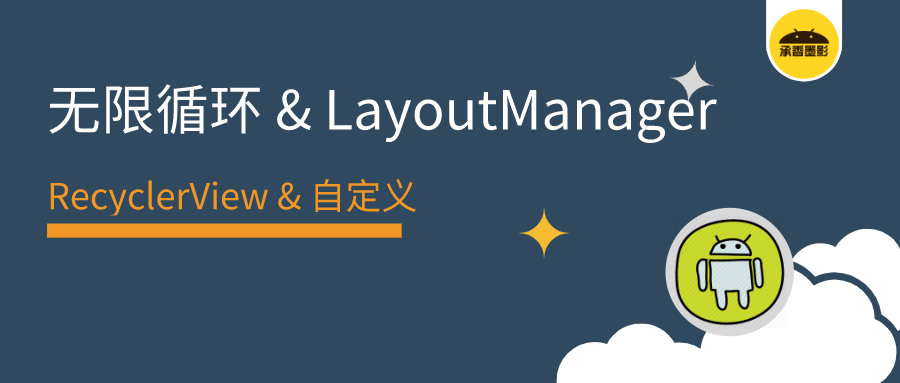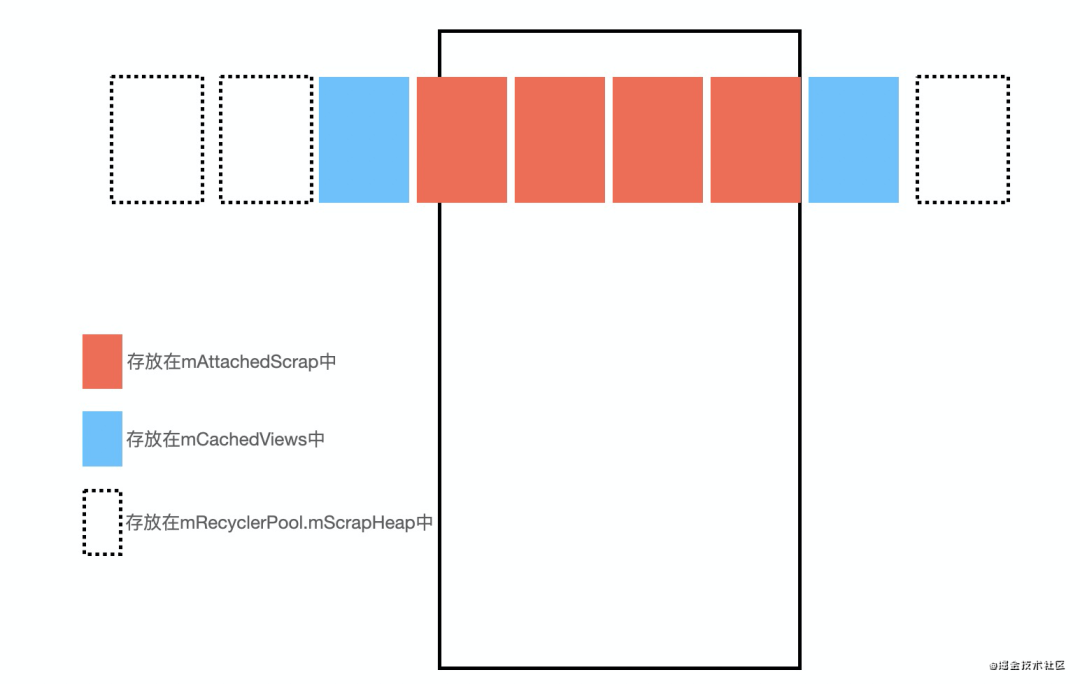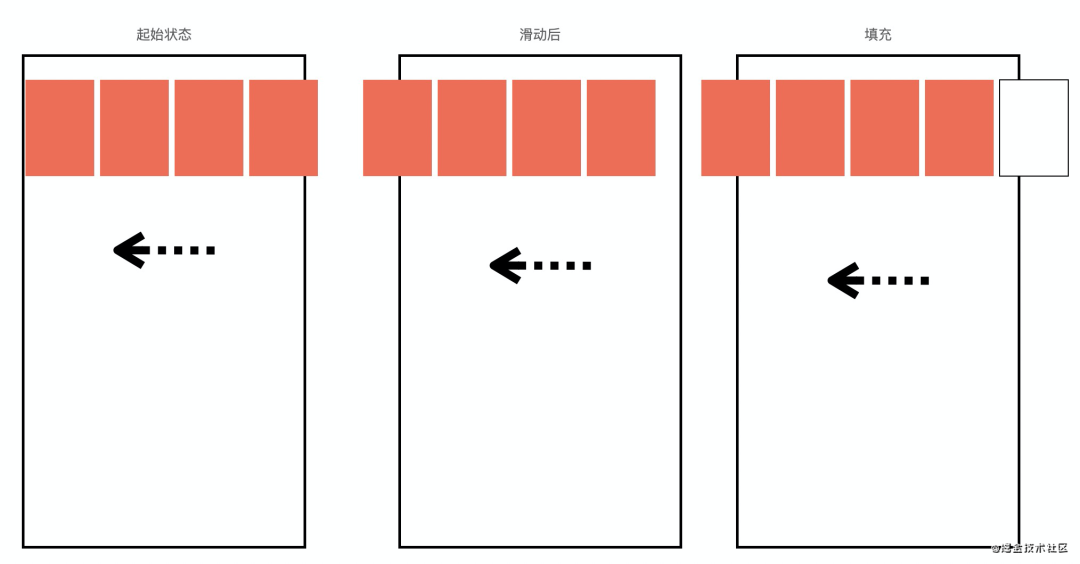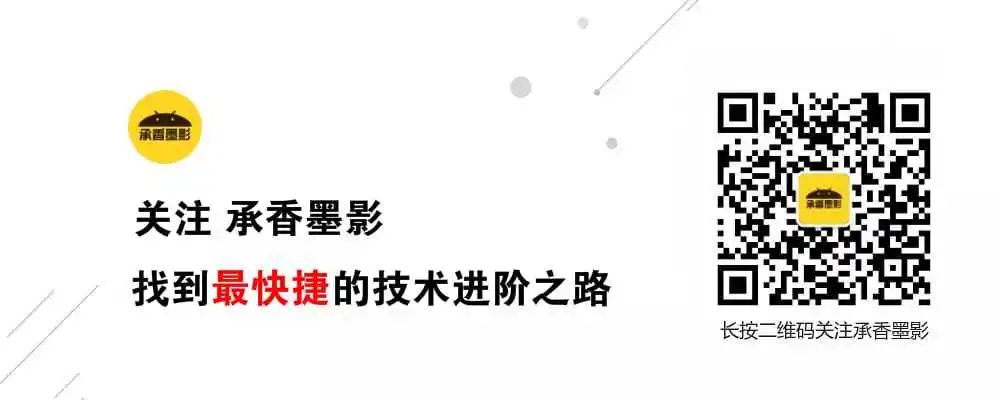
d袋鼠b | 作者
承香墨影 | 校对
https://juejin.cn/post/6909363022980972552 | 原文
大家好,这里是承香墨影!
在日常开发的过程中,同学们都遇到过需要 RecyclerView 无限循环的需求,但是在官方提供的几种 LayoutManager 中并未支持无限循环。
遇到此种问题,通常的解决方案是:
在
adapter返回Integer.MAX_VALUE,并让 RecyclerView 滑动到某个足够大的位置;选择自定义 LayoutManager,实现循环的 RecyclerView;
自定义 LayoutManager 的难度较高,本文将带大家一起实现这个自定义 LayoutManager,效果如下图所示。
同时,在熟悉了在自定义 LayoutManager 后,还可以根据需要调整 RecyclerView 的展示效果。
 |  |
与自定义 ViewGroup 类似,自定义 LayoutManager 所要做的就是 ItemView 的「添加 (add)」、「测量(measure)」、「布局 (layout)」。
但是与自定义 ViewGroup 相比,LayoutManager 多了一个「回收 (recycle)」工作。
在自定义 LayoutManager 之前,需要对其提供的「测量」、「布局」以及「回收」相关的 API 进行了解。
measure
首先介绍测量方法,与自定义 ViewGroup 类似,测量通常是固定的逻辑,不需要自己实现,开发者无需复写测量方法,只需要在布局之前调用测量函数来获取将要布局的「View 的宽度」即可。
LayoutManager 提供了两个用来测量子 View 的方法:
public void measureChild(@NonNull View child, int widthUsed, int heightUsed)
public void measureChildWithMargins(@NonNull View child, int widthUsed, int heightUsed)
测量完成后, 便可以使用 getMeasuredWidth()、getMeasuredHeight() 直接获取 View 的宽高,但是在自定义 LayoutManager 中需要考虑 ItemDecoration,所以需要通过如下两个 API 获取测量后的 View 大小:
public int getDecoratedMeasuredWidth(@NonNull View child) {
final Rect insets = ((LayoutParams) child.getLayoutParams()).mDecorInsets;
return child.getMeasuredWidth() + insets.left + insets.right;
}
public int getDecoratedMeasuredHeight(@NonNull View child) {
final Rect insets = ((LayoutParams) child.getLayoutParams()).mDecorInsets;
return child.getMeasuredHeight() + insets.top + insets.bottom;
}
layout
然后介绍 layout 方法,和自定义 ViewGroup 一样, LayoutManager 完成 ItemView 的测量后就是布局了。
在 LayoutManager 中,并非靠直接调用 ItemView 的 layout 函数进行子 View 的布局,而是使用 layoutDecorated 与 layoutDecoratedWithMargins, 两者的区别是后者考虑了 Margins:
public void layoutDecorated(@NonNull View child, int left, int top, int right, int bottom) {
final Rect insets = ((LayoutParams) child.getLayoutParams()).mDecorInsets;
child.layout(left + insets.left, top + insets.top, right - insets.right,
bottom - insets.bottom);
}
public void layoutDecoratedWithMargins(@NonNull View child, int left, int top, int right,
int bottom) {
final LayoutParams lp = (LayoutParams) child.getLayoutParams();
final Rect insets = lp.mDecorInsets;
child.layout(left + insets.left + lp.leftMargin, top + insets.top + lp.topMargin,
right - insets.right - lp.rightMargin,
bottom - insets.bottom - lp.bottomMargin);
}
recycle
回收是 RecyclerView 的灵魂,也是 RecyclerView 与普通 ViewGroup 的区别。众所周知,RecyclerView 中含有四类缓存,在布局过程中它们各自有各自的用途:
AttachedScrap: 存放可见、不需要重新绑定的 ViewHolder;
CachedViews: 存放不可见、不需要重新绑定的 ViewHoler;
ViewCacheExtension: 自定义缓存(存放不可见、不需要重新绑定);
RecyclerPool: 存放不可见、需要重新绑定的 ViewHolder;

在 LayoutManager 中提供了多个回收方法:
public void removeAndRecycleView(@NonNull View child, @NonNull Recycler recycler) {
removeView(child);
recycler.recycleView(child);
}
public void removeAndRecycleViewAt(int index, @NonNull Recycler recycler) {
final View view = getChildAt(index);
removeViewAt(index);
recycler.recycleView(view);
}
1、实现抽抽象方法,并让 RecyclerView 可横向滑动
public class RepeatLayoutManager extends RecyclerView.LayoutManager {
@Override
public RecyclerView.LayoutParams generateDefaultLayoutParams() {
return new RecyclerView.LayoutParams(ViewGroup.LayoutParams.WRAP_CONTENT,
ViewGroup.LayoutParams.WRAP_CONTENT);
}
@Override
public boolean canScrollHorizontally() {
return true;
}
}
2、定义初始布局
在 onLayoutChildren(RecyclerView.Recycler recycler, RecyclerView.State state) 方法中对 ItemView 进行添加、测量、布局。
具体步骤如下:
使用
recycler.getViewForPosition(int pos)从缓存中获取子 View;当可布局区域有多余的空间时, 通过
addView(View view)将对子 View 进行添加,通过在 RecyclerView 中添加子 View, 并对子 View 进行测量与布局,直至子 View 超出 RecyclerView 的可布局宽度;
@Override
public void onLayoutChildren(RecyclerView.Recycler recycler, RecyclerView.State state) {
if (getItemCount() <= 0) {
return;
}
if (state.isPreLayout()) {
return;
}
detachAndScrapAttachedViews(recycler);
int itemLeft = getPaddingLeft();
for (int i = 0; ; i++) {
if (itemLeft >= getWidth() - getPaddingRight()) {
break;
}
View itemView = recycler.getViewForPosition(i % getItemCount());
addView(itemView);
measureChildWithMargins(itemView, 0, 0);
int right = itemLeft + getDecoratedMeasuredWidth(itemView);
int top = getPaddingTop();
int bottom = top + getDecoratedMeasuredHeight(itemView) - getPaddingBottom();
layoutDecorated(itemView, itemLeft, top, right, bottom);
itemLeft = right;
}
}
3、滑动与填充
offsetChildrenHorizontal(int x) 用作对 RecyclerView 中的子 View 进行整体左右移动。为了在滑动 RecyclerView 时有子 View 移动的效果,需要复写 scrollHorizontallyBy() 函数,并在其中调用 offsetChildrenHorizontal(int x)。
当左滑后子 View 被左移动时,RecyclerView 的右侧会出现可见的未填充区域,这时需要在 RecyclerView 右侧添加并布局好新的子 View,直到没有可见的未填充区域为止。

同样,在右滑后需要对左侧的未填充区域进行填充。
具体代码如下:
@Override
public int scrollHorizontallyBy(int dx, RecyclerView.Recycler recycler, RecyclerView.State state) {
fill(recycler, dx > 0);
offsetChildrenHorizontal(-dx);
return dx;
}
private void fill(RecyclerView.Recycler recycler, boolean fillEnd) {
if (getChildCount() == 0) return;
if (fillEnd) {
View anchorView = getChildAt(getChildCount() - 1);
int anchorPosition = getPosition(anchorView);
for (; anchorView.getRight() < getWidth() - getPaddingRight(); ) {
int position = (anchorPosition + 1) % getItemCount();
if (position < 0) position += getItemCount();
View scrapItem = recycler.getViewForPosition(position);
addView(scrapItem);
measureChildWithMargins(scrapItem, 0, 0);
int left = anchorView.getRight();
int top = getPaddingTop();
int right = left + getDecoratedMeasuredWidth(scrapItem);
int bottom = top + getDecoratedMeasuredHeight(scrapItem) - getPaddingBottom();
layoutDecorated(scrapItem, left, top, right, bottom);
anchorView = scrapItem;
}
} else {
View anchorView = getChildAt(0);
int anchorPosition = getPosition(anchorView);
for (; anchorView.getLeft() > getPaddingLeft(); ) {
int position = (anchorPosition - 1) % getItemCount();
if (position < 0) position += getItemCount();
View scrapItem = recycler.getViewForPosition(position);
addView(scrapItem, 0);
measureChildWithMargins(scrapItem, 0, 0);
int right = anchorView.getLeft();
int top = getPaddingTop();
int left = right - getDecoratedMeasuredWidth(scrapItem);
int bottom = top + getDecoratedMeasuredHeight(scrapItem) - getPaddingBottom();
layoutDecorated(scrapItem, left, top,
right, bottom);
anchorView = scrapItem;
}
}
return;
}
前面讲到,当对 RecyclerView 进行滑动时,需要对可见的未填充区域进行填充。然而一直填充不做回收 Item,那就和普通的 ViewGroup 没有太多的区别了。
在 RecyclerView 中,需要在滑动、填充可见区域的同时,对不可见区域的子 View 进行回收,这样才能体现出 RecyclerView 的优势。
回收的方向与填充的方向恰好相反。那回收的代码具体如何实现呢?
代码如下:
@Override
public int scrollHorizontallyBy(int dx, RecyclerView.Recycler recycler, RecyclerView.State state) {
fill(recycler, dx > 0);
offsetChildrenHorizontal(-dx);
recyclerChildView(dx > 0, recycler);
return dx;
}
private void recyclerChildView(boolean fillEnd, RecyclerView.Recycler recycler) {
if (fillEnd) {
for (int i = 0; ; i++) {
View view = getChildAt(i);
boolean needRecycler = view != null && view.getRight() < getPaddingLeft();
if (needRecycler) {
removeAndRecycleView(view, recycler);
} else {
return;
}
}
} else {
for (int i = getChildCount() - 1; ; i--) {
View view = getChildAt(i);
boolean needRecycler = view != null && view.getLeft() > getWidth() - getPaddingRight();
if (needRecycler) {
removeAndRecycleView(view, recycler);
} else {
return;
}
}
}
}
添加依赖
implementation 'cn.student0.manager:repeatmanager:1.0.3'
在代码中使用
RecyclerView recyclerView = findViewById(R.id.rv_demo);
recyclerView.setAdapter(new DemoAdapter());
recyclerView.setLayoutManager(new RepeatLayoutManager
到此,无限循环的 LayoutManager 的实现已经完成。文章的不足还请指出,谢谢大家。
-- End --
Github 地址:https://github.com/jiarWang/RepeatLayoutManager 欢迎大家 Star。
reference:
https://blog.csdn.net/u011387817/article/details/81875021
https://blog.csdn.net/zxt0601/article/details/52948009
本文对你有帮助吗?留言、转发、点好看是最大的支持,谢谢!
推荐阅读:
面试问Handler内存泄露的场景,别就只知道静态内部类&弱引用!
Flutter 利用 FFI,绕过 Android JNI 直接调用 C++ 层!
已开源!Flutter 基于分帧渲染的流畅度优化组件 Keframe






















 420
420











 被折叠的 条评论
为什么被折叠?
被折叠的 条评论
为什么被折叠?








